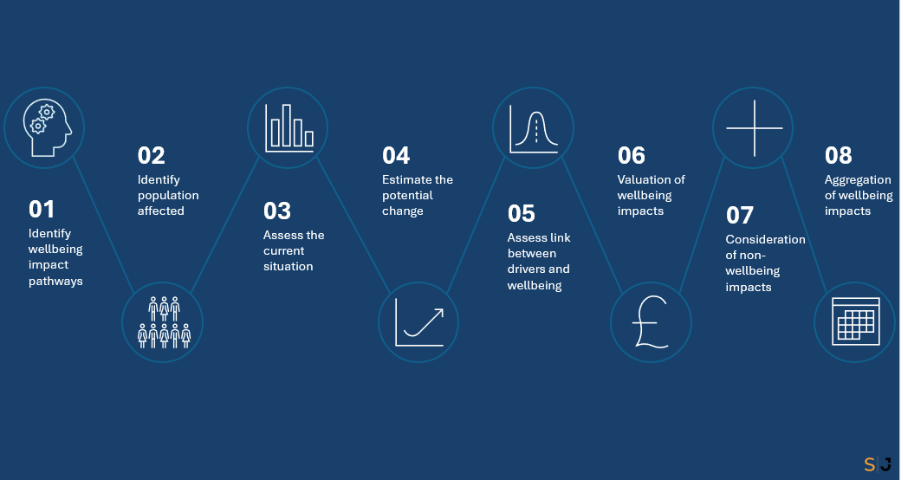Introduction
At Simetrica-Jacobs we follow a Green Book-aligned process for bringing wellbeing into transport appraisal. In practice, as shown in the figure below, this means:
- identifying the wellbeing drivers associated with a project or scheme,
- defining the affected population,
- setting the baseline,
- estimating the change for each driver,
- evidencing the link between drivers and wellbeing,
- valuing wellbeing impacts where appropriate,
- considering non-wellbeing and distributional effects,
- and aggregating results for the business case.
The aim is to capture how transport interventions may impact on people’s quality of life in a way that is proportionate and transparent.

If you are new to wellbeing valuation, we set out the approach in an earlier post, including what it is, why it matters, and how it can be applied in practice. You can read that overview here: Simetrica Jacobs: Wellbeing Valuation: What is it and how can it be used?
Standard transport appraisal still misses important effects
DfT’s Transport analysis guidance (TAG) is already comprehensive and well regarded internationally. Time savings, safety, and environment are central. However, in practice, some social and distributional effects are still under-represented or are brought in late to the appraisal. These include access to services, perceived safety, and changes in security, journey quality and physical activity. These are often the outcomes people feel impact them most in daily life. Treating them as an add-on can mean the case for some options is thinner than it should be.
The Department for Transport’s recent review of TAG through a wellbeing lens recognises this gap and sets out where wellbeing evidence can strengthen appraisal, highlighting the strongest links and offering practical pointers for bringing wellbeing forward in a proportionate and transparent way. Taken together, this makes a strong case for using wellbeing evidence alongside established TAG impacts and integrating it into the Economic Case and value-for-money advice, rather than treating it as a bolt-on.
That said, integrating monetised wellbeing effects alongside established TAG impacts is not straightforward. As the DfT report notes, there are issues around attribution and the risk of double counting when combining wellbeing values with other impacts. Nonetheless, this should not be a reason to avoid wellbeing analysis. The intent is not to replace existing values but to widen the lens where material effects would otherwise be missed. The key is to be clear about assumptions, uncertainty and any potential overlap with the TAG-related impacts, so the analysis remains credible.
Building on this, the updated DfT Value for Money framework is a welcome development for wellbeing practitioners. It provides a ‘compliant route’ to include monetised wellbeing effects in decision-making. As the volume of research in this area continues to grow, the potential exists for these benefits to be incorporated as evolving monetised impacts to be included in the adjusted BCR. With the recent changes to the DfT value for money framework, there is definite scope for including them as part of the indicative BCR already. Appraisal teams can now present indicative monetised impacts with clear caveats, and then combine these with other factors such as non-monetised and distributional evidence to reach an overall value-for-money judgement. Used in this way, the BCR and accompanying evidence can reflect the full range of a scheme’s benefits, rather than overlooking material wellbeing impacts.
Next steps
Wellbeing valuation methods are evolving, and some uncertainties remain. Issues such as double counting, attribution, and adaptation need careful handling. Particular attention should be given to the risk of overlapping wellbeing values with other impacts such as health outcomes, time savings, safety, noise, and environmental effects. This is not a reason to pause progress. It is a reason to be explicit and proportionate.
In the future, more guidance is needed, and there is hope that monitoring and evaluation of transport appraisal projects can be used to back up appraisal assumptions and make later appraisal more credible. Bringing wellbeing analysis into the Economic Case and the Value for Money assessment, with clear alignment to the Strategic Case, helps decision-makers see the full picture, not just the traditional metrics of conventional appraisal.
Want to learn more, or work out how to integrate Wellbeing Valuation into the appraisal of transport projects? Book a 1-1 with our Chief Economist, Ed Dallas, today: e.dallas@simetrica-jacobs.com
And be sure to follow us on LinkedIn for updates on our ‘Three Things’ series – bite size insights on all things social value and impact measurement!

